Serapis Bey/fr: Difference between revisions
(Created page with "En se tenant devant le Parthénon, on se trouve en présence d'un morceau d'architecture conçu par un individu qui sait comment utiliser la forme, la symétrie, la géométrie, les angles pour abriter une flamme. Le champ de force du Parthénon contient effectivement une flamme essentielle, tout comme le temple de Louxor et la grande pyramide.") |
(Created page with "Phidias a également créé une immense statue de Zeus en or et en ivoire qui se trouvait dans le temple d'Olympie. Il était également peintre, graveur et maître du travail des métaux. Son art se caractérise par sa beauté exaltée et sa spiritualité, et il a vécu comme la personnification ultime de l'âge d'or des maîtres artistes grecs qui a exercé une influence durable sur tout l'art occidental ultérieur.") Tags: Mobile edit Mobile web edit |
||
| Line 72: | Line 72: | ||
En se tenant devant le Parthénon, on se trouve en présence d'un morceau d'architecture conçu par un individu qui sait comment utiliser la forme, la symétrie, la géométrie, les angles pour abriter une flamme. Le champ de force du Parthénon contient effectivement une flamme essentielle, tout comme le temple de Louxor et la grande pyramide. | En se tenant devant le Parthénon, on se trouve en présence d'un morceau d'architecture conçu par un individu qui sait comment utiliser la forme, la symétrie, la géométrie, les angles pour abriter une flamme. Le champ de force du Parthénon contient effectivement une flamme essentielle, tout comme le temple de Louxor et la grande pyramide. | ||
Phidias a également créé une immense statue de Zeus en or et en ivoire qui se trouvait dans le temple d'Olympie. Il était également peintre, graveur et maître du travail des métaux. Son art se caractérise par sa beauté exaltée et sa spiritualité, et il a vécu comme la personnification ultime de l'[[Âge d'or de la Grèce|âge d'or des maîtres artistes grecs]] qui a exercé une influence durable sur tout l'art occidental ultérieur. | |||
Phidias | |||
<div lang="en" dir="ltr" class="mw-content-ltr"> | <div lang="en" dir="ltr" class="mw-content-ltr"> | ||
Revision as of 14:33, 26 April 2025
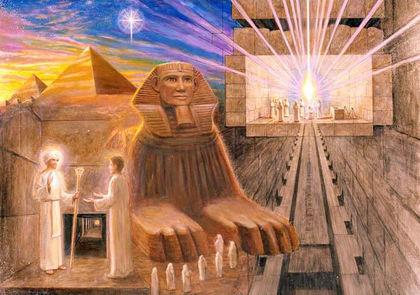
Sérapis Bey est le Seigneur (Chohan) du quatrième rayon; hiérarque du temple de l’Ascension à Louxor en Égypte, et treizième membre du conseil des adeptes du temple de l’Ascension. Il est également connu sous le nom de Sérapis Soleil.
Le quatrième rayon est la flamme de l’Ascension, la lumière blanche de la Mère dans le chakra de la base. L’architecture, les principes mathématiques, les fondations des temples de matière et la pyramide du Soi proviennent de la lumière blanche. En la présence de Sérapis chacun comprend différemment le concept de ce que nous appelons le Christ, la vraie personne en nous.
Incarnations
[Cet article a été traduit par DeepL de ce paragraphe jusqu'à la fin et doit donc être révisé.]
Connu sous le nom de Grand Disciplinaire, Sérapis vint de Vénus avec l'Ancien des Jours pour rallumer le feu sacré dans le cœur de l'humanité égarée. Son grand enthousiasme pour récupérer les fils de l'homme comme rois et prêtres de Dieu s'enfla et se transforma en une flamme de volonté de fer, de détermination et de discipline.
Grand Prête dans le temple de l’Ascension
Il était prêtre dans le Temple de l'Ascension sur l'Atlantide. En tant que gardien de la flamme de l'ascension, il la transporta en toute sécurité sur le Nil jusqu'à Louxor, juste avant que l'Atlantide ne sombre. Sérapis nous donne un aperçu de cette expérience avec ses propres mots :
Je me souviens très bien de l'époque où les premières rumeurs sur le naufrage de l'Atlantide ont été entendues. Car, comme vous le savez, le naufrage de ce continent s'est fait par étapes. Par la grâce de Dieu, l'avertissement donné a permis à beaucoup d'en réchapper. Et nous nous sommes rendus à Luxor....
Vous vous demandez peut-être pourquoi une flamme spirituelle doit être transportée par de simples mortels. Les enfants de la lumière ont toujours tendance à penser que de telles choses doivent se produire de manière magique et miraculeuse. Peut-être qu'un peu de conte de fées s'est répandu dans la religion et que les gens ont oublié que tout ce qui a été accompli par Dieu et par l'homme a été le fruit d'un travail et d'un effort conjoints, en haut et en bas.
Je vais donc vous dire pourquoi il en est ainsi - parce que le seul endroit où la flamme peut vraiment demeurer, en dehors de l'autel ainsi consacré, est le cœur vivant de l'adepte vivant.[1]
En Égypte, Sérapis et les frères qui l'accompagnaient construisirent le Temple de l'Ascension, et c'est là qu'ils ont gardé la flamme depuis lors, alternant les tâches au fur et à mesure qu'ils continuaient à se réincarner spécifiquement dans ce but.
Sérapis Bey continua à se réincarner au pays du Nil, renonçant à sa propre ascension jusqu'à environ 400 B.C.. Au cours de ces vies, il est devenu le commanditaire de certaines des plus grandes réalisations architecturales qui aient jamais vu le jour sur terre.
Architecte de la Grande Pyramide
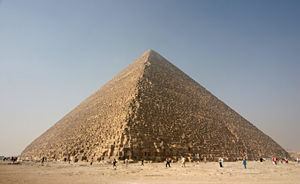
Sérapis était l'architecte de la Grande Pyramide et El Morya en était le maître maçon. La Grande Pyramide est la gravure dans la pierre de l'enregistrement du chemin d'initiation par lequel l'âme, commençant dans la Matière, la base de la pyramide, les quatre côtés, s'élève du centre de la pyramide jusqu'à l'apex. L'élévation de cette flamme est la méditation sur la lumière blanche qui voyage dans le corps physique de la base de la colonne vertébrale à la couronne.
Jésus et El Morya expliquent que "la construction de la pyramide du Soi est une construction intérieure, mais l'équation extérieure doit être conforme, doit montrer des fruits, doit donner l'exemple pour que d'autres puissent vous suivre jusqu'au cœur du Sphinx - au cœur même du Gourou vivant que le Sphinx représente et au cœur de la flamme dans la Grande Pyramide qui est sur l'octave éthérique (et qui n'est pas détenue dans la pyramide de Gizeh, qui reste la coquille de son ancien foyer et de sa fonction à cause de la mauvaise utilisation de son énergie par les magiciens noirs, les faux gourous et les faux chélas)." [2].
Amenhotep III
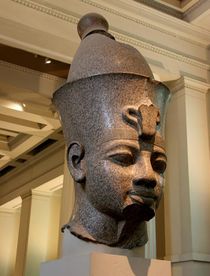
Serapis was embodied as the Egyptian Pharaoh Amenhotep III (reigned c. 1417–1379 B.C.), the son of Thutmose IV and the great grandson of Thutmose III, an incarnation of Kuthumi. His son and successor to the throne was Amenhotep IV, later known as Ikhnaton. During Serapis’ reign, Egypt was at her height of prosperity, peace and splendor, which were the direct manifestation of his communion with his own heart flame and with the ascended masters all the way back to the Ancient of Days.
Amenhotep III était considéré comme le plus grand souverain de la planète. Pendant la majeure partie de son règne, il a entretenu des relations diplomatiques pacifiques avec toutes les nations. Une partie de la grande richesse de son trésor a été consacrée à la construction de temples et de palais magnifiques. Il agrandit le temple de Karnak sur le Nil et construit un immense temple funéraire, dont les vestiges sont aujourd'hui connus sous le nom de Colosses, ces statues monolithiques assises découvertes sur les rives du fleuve. Il a cherché à exprimer dans la pierre la compréhension de l'ordre hiérarchique des initiés, des maîtres ascensionnés, des rois philosophes qui avaient parcouru la terre au cours des premiers âges d'or.
Sa plus grande construction fut celle du temple de Louxor, qui est encore partiellement intact aujourd'hui. Ce temple incarnait dans sa géométrie et sa conception la représentation physique de la loi ésotérique transmise par les prêtres depuis des générations. Il constitue un véritable manuel de science, d'art et de philosophie avancés. Le temple de Louxor est aujourd'hui la contrepartie physique de la retraite éthérique qu'est le temple de l'Ascension.
Leonidas
► Article principal: Thermopylae
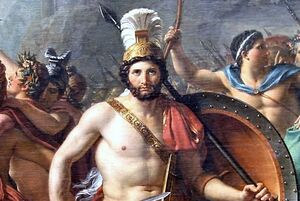
Serapis also embodied as the Spartan king Leonidas (died c. 480 B.C.), who commanded the Greeks in their heroic stand against the immense Persian invasion at the pass of Thermopylae, gateway to central Greece.
Bien que les Perses soient plus nombreux que les Grecs, Léonidas résiste pendant deux jours à l'avancée de l'armée perse du roi Xerxès. Le troisième jour, alors que les Perses approchent par l'arrière et qu'aucun renfort n'est en vue, Léonidas licencie la plupart de ses troupes. Avec l'aide des alliés grecs restants, Léonidas et ses trois cents membres de la garde royale spartiate se sont battus jusqu'au dernier homme. Leur héroïsme a permis à la flotte grecque de battre en retraite, puis de vaincre les Perses. L'exemple de Léonidas a contribué à entretenir l'étincelle de l'identité nationale de la nation grecque.
Les historiens citent cette bataille comme un excellent exemple de courage et d'intrépidité dans la lutte pour une cause contre des obstacles considérables. Les archives akashiques révèlent que les trois cents Spartiates étaient le rassemblement de trois cents chélas de Louxor qui étaient en incarnation avec Sérapis. Ils représentaient un type extraordinaire de virilité. Certains sont aujourd'hui des maîtres ascensionnés, d'autres restent en incarnation.
À l'époque, il s'agissait d'une guerre physique contre des obstacles physiques. Aujourd'hui, c'est une bataille d'Armageddon contre la méchanceté spirituelle dans les hauts lieux de l'Église et de l'État - l'esprit de Dieu consumant l'anti-esprit, le grand Soi consumant le non-soi.
Phidias

Serapis Bey was embodied as the sculptor Phidias during the fifth century B.C. in Athens. He was regarded as the greatest of all the Greek sculptors. He was the architect of the Parthenon, supervising its exquisitely masterful construction. Within the Parthenon he placed his most famous work, the forty-foot high statue in gold and ivory of Pallas Athena, the representation of the Mother figure, the Goddess of Truth.
En se tenant devant le Parthénon, on se trouve en présence d'un morceau d'architecture conçu par un individu qui sait comment utiliser la forme, la symétrie, la géométrie, les angles pour abriter une flamme. Le champ de force du Parthénon contient effectivement une flamme essentielle, tout comme le temple de Louxor et la grande pyramide.
Phidias a également créé une immense statue de Zeus en or et en ivoire qui se trouvait dans le temple d'Olympie. Il était également peintre, graveur et maître du travail des métaux. Son art se caractérise par sa beauté exaltée et sa spiritualité, et il a vécu comme la personnification ultime de l'âge d'or des maîtres artistes grecs qui a exercé une influence durable sur tout l'art occidental ultérieur.
As far as we know, Serapis Bey ascended about 400 B.C.
Worship in Egypt
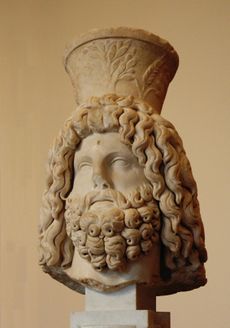
In the Hellenistic age, from 323 to 31 B.C., Serapis became one of the most important gods of the Egyptian and Greco-Roman pantheons. He was revered as the patron of the Ptolemaic kings of Egypt and as the founding deity of the great city of Alexandria. There are numerous historical records of the intimate contact of Serapis with men throughout Egypt and Asia Minor, and there are over 1,080 statues, temples and monuments dedicated to Serapis Bey that were erected during that era.
Demetrius of Phalarum, the founder of the Alexandrian library under Ptolemy I, was miraculously cured of blindness by Serapis and wrote hymns of thanksgiving. Serapis often spoke through oracles and gave counsel as well as personal, miraculous healings to many people. There is a famous historical account involving Serapis that marked an important era in the establishment of him as the most prominent deity of Egypt and Greece. King Ptolemy I, ruler of Egypt, was visited in a dream by Serapis, who commanded the king to bring the god’s statue to Alexandria. After vacillation and a second dream with Serapis, the king had the statue brought with the blessings of the Delphic Oracle and installed it in the Serapium, or great Temple, of Alexandria. This is the temple that contained the famous Alexandrian library of three hundred thousand volumes.
Many epithets are ascribed to Serapis, including “Father,” “Saviour” and “the greatest of the deities.” He was regarded as the sponsor of intimate contact between the gods and mortals. Serapis is regarded in the annals of the esoteric tradition as the hierophant of the secret Egyptian initiatory rites. The lesser mysteries were dedicated to Isis and intended for the layman; the greater mysteries were dedicated to Serapis and Osiris and transmitted only to initiated priests who underwent severe rites of trial and initiation in the temple of Serapis.
Over a period of six to seven hundred years, Serapis became the supreme deity of Egypt and Greece. However, in the late fourth century A.D., the emperor Theodosius issued edicts against polytheism, and Christians took this as license to attack pagans, including the adherents of mystery religions. The Christian Bishop of Alexandria provoked mobs to destroy the great symbol of paganism in Alexandria, the mystery temple of the god Serapis. They hacked apart the huge statue of Serapis, which had inspired worshipers for six hundred years. The mob destroyed at least one of Alexandria’s great libraries.
Work with the Theosophical Society
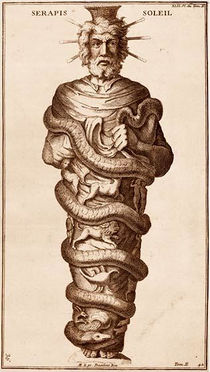
Serapis Bey played a vital role in the initial thrust and direction of the endeavors of the Brotherhood during the nineteenth century. Among the earliest letters from the adepts and masters to the founders of the Theosophical Society were those of Serapis Bey and the Brotherhood of Luxor.
Serapis took personal charge of the direction and chelaship of the amanuensis Helena Blavatsky and of Colonel Henry Steel Olcott, who was the co-founder and the president of the Theosophical Society. During the six months preceding the formation of the society in 1875, Serapis sent many letters of encouragement and instruction to Colonel Olcott. The letters were written mostly on thick green parchment in gold ink, signed by Serapis in script, and inscribed with an esoteric symbol of the Brotherhood of Luxor.
It is characteristic of the letters written to Henry Olcott that he continually gave the exhortation to him, “Try.” The master Serapis stressed the need for courage and fearlessness, the same strong traits he outpictured as Leonidas.
Serapis’ mission today
The ascended master Serapis Bey today occupies a very key position among the seven chohans. The fourth ray is midpoint between three on one side and three on the other. The center figure of four is key because it is the merging of the white light and the nexus of the figure-eight flow of energy. This point of the Mother flame is always embodied in the guru East or West, the person of the Mother in Sanat Kumara who moves in and among us by that white light.
The white light is the sacred fire of creation, and its perversion becomes black magic. This was seen in Egypt, the focal point of the ascension flame, as the practice of black magic by the Egyptian Black Brotherhood that went on for centuries upon centuries in defiance of the very presence of Serapis Bey within his temple.
The point of redemption of earth goes back to Lemuria, the Motherland and the Mother flame itself. Earth has a tremendous karma with the Mother flame and in the perversions of the Mother flame that took place on Lemuria, in the area of where San Francisco is now located and off the coast of California. The perversions of the Mother light opened the way for the desecration of the temples, the fall of the priests and priestesses, ultimately ending in misuse of the sexual energies and perversions of the life force. The final act was the murder of the highest representative of the Mother on Lemuria. The real cause of the sinking of Lemuria was the desecration of the person of the Mother and her flame.
Since that hour, earth has been slowly coming to the age of Aquarius when once again the light of the Mother could be raised up in all, both male and female, bringing about once again the honoring of the woman and of the Mother and a reunion of the Mother, the light rising from the base, with the light of the Father that descends out of the I AM Presence. The next two thousand years is destined to see the raising up of consciousness such as has not occurred since the golden ages of Lemuria.
The path of the ascension is the resolution of those forces that are necessary within our consciousness—Father, Mother, Son and Holy Spirit as the four pillars of the temple within us. Gautama Buddha’s great lesson was that all suffering is caused by being out of alignment with the inner light through wrong desire. Serapis Bey teaches us how to get into alignment with the inner will of Being. His teachings become the keystone in the arch of hierarchy. Without the white light, we cannot enjoy the integration of selfhood.
Serapis Bey, then, becomes a very important key at a time when there are so many problems in society. The increase in crime, murder, rape, drugs, and so forth is the sign of the coming of the Mother light, rising from the altars of Lemuria. The rising light becomes so intense that, unless we dive into it and become a part of it, it becomes the rock that Jesus spoke of—unless we fall upon that rock and allow our misconceptions to be broken, it breaks us.[3]
It is the light that resolves identity, but is also the light that is so powerful that it can destroy the false identity that rebels against it. At the dawning of the age of Aquarius, the world is in rebellion against the light of God, and yet the world is seeking God. The teaching of Serapis Bey and the mysteries of the Brotherhood of Luxor contain the answers that can resolve these questions.
Serapis Bey has legions of seraphim in his command. He has great attainment in divine geometry and design. He assists his disciples in the self-disciplines that are necessary for the ascension: the discipline of the four lower bodies in order that the Christ may appear and use them as vehicles for service and attainment in the world of form; the disciplining of past momentums of negative spirals and of human creation that would stand in the way of the ascension flame forming within the heart of everyone evolving upon the planet through the acceleration of the threefold flame.
The path of the ascension
His book Dossier on the Ascension is a textbook on the path of the ascension. It contains teachings from the classes he conducts at the Ascension Temple, and through it, you can have anchored in your conscious mind that which you learn at the Ascension Temple at Luxor while your body sleeps at night. He outlines the requirements of the ascension and provides a thorough explanation and instruction on the process of the ascension.
Serapis describes what happens during the ritual of the ascension:
It is true, although the form of an individual may show signs of age prior to his ascension, that all of this will change and the physical appearance of the individual will be transformed into the glorified body. The individual ascends, then, not in an earthly body but in a glorified spiritual body into which the physical form is changed on the instant by total immersion in the great God flame.
Thus, man’s consciousness of the physical body ceases and he achieves a state of weightlessness. This resurrection takes place as the great God flame envelops the shell of human creation that remains and transmutes, in a pattern of cosmic grids, all of the cell patterns of the individual—the bony structure, the blood vessels and all bodily processes, which go through a great metamorphosis.
The blood in the veins changes to liquid golden light; the throat chakra glows with an intense blue-white light; the spiritual eye in the center of the forehead becomes an elongated God flame rising upward; the garments of the individual are completely consumed, and he takes on the appearance of being clothed in a white robe—the seamless garment of the Christ. Sometimes the long hair of the Higher Mental Body [the Holy Christ Self] appears as pure gold on the ascending one; then again, eyes of any color may become a beautiful electric blue or a pale violet....
Lighter and lighter grows the physical form, and with the weightlessness of helium the body begins to rise into the atmosphere, the gravitational pull being loosened and the form enveloped by the light of the externalized glory which man knew with the Father “in the beginning” before the world was....
These changes are permanent, and the ascended one is able to take his light body with him wherever he wishes, or he may travel without the glorified spiritual body. Ascended beings can and occasionally do appear upon earth as ordinary mortals, putting on physical garments resembling the people of earth and moving among them for cosmic purposes. This Saint Germain did after his ascension when he was known as the Wonderman of Europe. Such an activity is a matter of dispensation received from the Karmic Board.[4]
(Generally, however, ascended beings do not return to the physical plane unless there is some specific service requiring this change in vibratory rate.)
Serapis tells us, “You ascend daily.” Our thoughts, our feelings, our daily deeds are all weighed in the balance. We do not ascend all at once, but by increments as we pass our tests and win our individual victories. The entire record of all our past lives and momentums of both good and evil must be counted; and then, when we have brought at least 51 percent of all the energy that has ever been allotted to us into balance with the purity and harmony of the Great God Self, we may be offered the gift of the ascension. The remaining 49 percent must be transmuted, or purified, from the ascended octaves through service to earth and her evolutions.[5]
Serapis Bey, the chohan of the ascension flame and hierarch of the Ascension Temple at Luxor, Egypt, speaks to each one of us:
The future is what you make it, even as the present is what you made it. If you do not like it, God has provided a way for you to change it, and the way is through the acceptance of the currents of the ascension flame.[6]
Guiseppe Verdi captured the music of the ascension flame in the “Triumphal March” from Aïda. The keynote of the Ascension Temple is “Liebestraum,” by Franz Liszt, and the radiance of the Electronic Presence of Serapis Bey and his twin flame pour through the aria “Celeste Aïda.”
See also
For more information
Mark L. Prophet and Elizabeth Clare Prophet, Lords of the Seven Rays.
Serapis Bey, Dossier on the Ascension.
Sources
Mark L. Prophet and Elizabeth Clare Prophet, The Masters and Their Retreats, s.v. “Serapis Bey.”
- ↑ Serapis Bey, "La mobilisation des forces spirituelles", Pearls of Wisdom, vol. 25, no. 60.
- ↑ Jésus et El Morya, " L'Ordre du Bon Samaritain ", Pearls of Wisdom, vol. 27, no. 52, 28 octobre 1984.
- ↑ Matt. 21:44; Luke 20:18.
- ↑ Serapis Bey, Dossier on the Ascension, pp. 158, 176–77.
- ↑ In addition to balancing 51 percent of one’s karma, the requirements for the ascension are to balance the threefold flame, align the four lower bodies, attain a certain mastery on all seven rays, achieve a degree of mastery over outer conditions, fulfill one’s divine plan, transmute the electronic belt, and raise the Kundalini.
- ↑ Ibid., p. 89.
